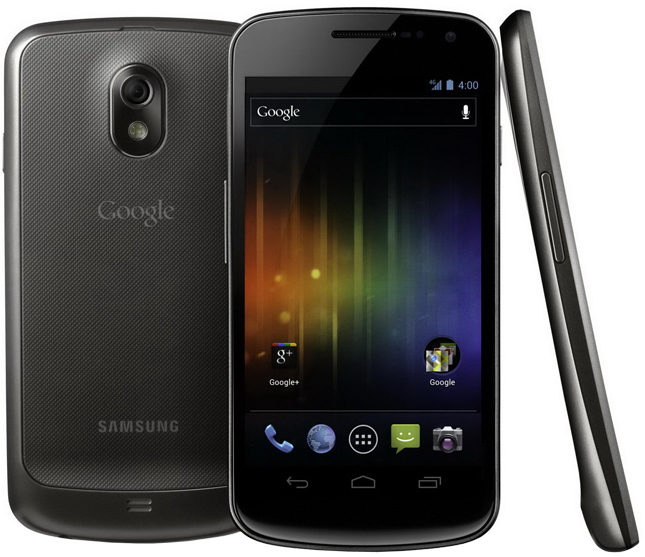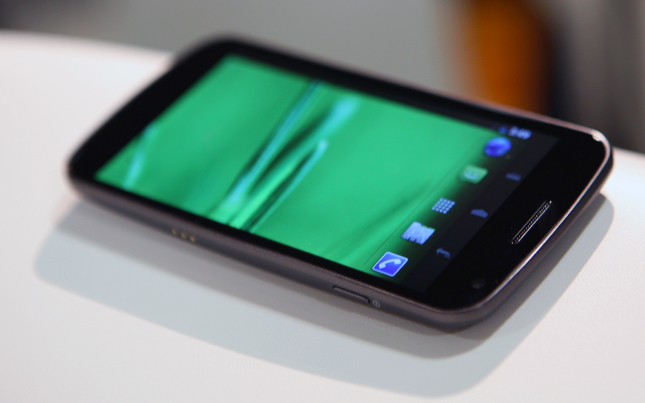40 minutes with Galaxy Nexus

Samsung and Google this time came to a common opinion and released not two identical smartphones with different designs, but one - with the collective name Galaxy Nexus.
')
Until recently, I thought that my personal smartphone, the Samsung Galaxy S II, was big. It turns out no longer. Here is the Galaxy Nexus - great! Google equipped it with a screen with a diagonal of 4.65 inches, stuffed the most powerful stuffing inside and most importantly - installed a new Android 4.0 Ice Cream Sandwich operating system.
The screen of the new Nexus - Super AMOLED with a resolution of 1280 x 720 pixels. Pixels, of course, imperceptibly, because the density is higher than even when printing. Viewing angles are excellent, but for the moment, nothing can compare with the brightness of organic LEDs.
At the same time, the display is slightly curved, and the body itself becomes thinner closer to the edges, so the gadget is in hand, despite its impressive size, is pretty good.

On the left of the gadget is the volume control, on the right - the on / off button and the contact pad to connect to ... probably the docking station. Nothing specific guys from Samsung, who gave us hold on the device for about forty minutes, did not say about it.

Below there is a micro USB connector, a tiny microphone hole and a 3.5 mm audio jack. In my personal taste it would be better to display it on the upper end, but thanks also for the fact that the headphone plug will not stick out from the side.

On the back is a five-megapixel camera, under it - an LED flash. It makes quite suitable pictures, but it will not work to show them - there was no opportunity to transfer anywhere.
The back cover itself, in its thickness and texture, resembles the bumpy panel of the Samsung Galaxy S II - just as thin, flexible and rough.
There are no even touch buttons in front. All of them are replaced by on-screen - in the manner of the third version of Android. But there is a camera for video calls with a good resolution - 1.3 megapixels.

Inside the Galaxy Nexus dual-core processor (not the fact that it is the TI OMAP 4460, but it all converges on this version) with a clock frequency of 1.2 GHz, gigabytes of RAM and 16 to 32 gigabytes of main memory. The slot for microSD could not be found, which I suspect will sadden many.
Special mention worthy of a set of interfaces and various sensors. There is 3G, Bluetooth 3.0, Wi-Fi 802.11 a / b / g / n, NFC, accelerometer, compass, gear, proximity and lighting sensors, as well as a barometer.
In general, I can’t complain about performance: everything worked smartly and didn’t slow down at all.

Another thing is that the fourth Android itself in this particular device was extremely raw. That is, it is not even about version 4.0.1 - some kind of very early. It was not possible to connect with a Google account, so no synthetic tests, test shots and videos, sorry. The only thing we can say is that the system will look about the same on displays of various sizes - everything will just scale.
In the US and Europe, the novelty should appear in early November, but how much it will cost is a question. In principle, all the components are top, so I think those who want to get the Galaxy Nexus one of the first should prepare 25 thousand rubles, or even more.
TTX
OS: Android 4.0
Processor: ARM Cortex-A9, two 1.2 GHz cores,
Video :?
RAM: 1 GB
Main memory: 16/32 GB
Screen: 4.65 ", Super AMOLED, 720 x 1280
Communications: 3G, Wi-Fi 802.11 a / b / g / n, Bluetooth 3.0, USB 2.0, NFC
Connectors: USB 2.0, 3.5mm audio jack
Cameras: 5 megapixels, flash, autofocus + 1.3 megapixels for video calls
Navigation: GPS, GPS
Battery: 1750 mAh
Dimensions: 135.5 x 67.9 x 8.9 mm
Weight: 135 grams
Price :?
Source: https://habr.com/ru/post/130777/
All Articles